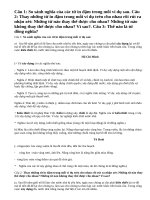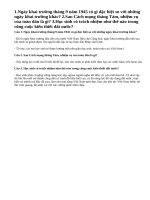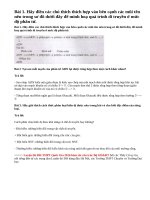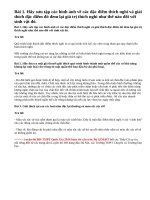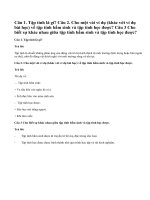Earths changing crust lessons 1 2 19 trang
Bạn đang xem bản rút gọn của tài liệu. Xem và tải ngay bản đầy đủ của tài liệu tại đây (5.05 MB, 19 trang )
Earth's
Changing
Crust
Lessons 1– 2
Grade 6
CA Unit 1
w w w.harcour tschool.com
ISBN-13: 978-0-15-349202-0
ISBN-10: 0-15-349202-3
Ë|xHSKBPDy492020zv*:+:!:+:!
CXECA08ARD601_LLR_CVa.indd 2-3
>
2/21/06 5:58:23 PM
Think About the Reading
1. How are the crust, mantle, and core different? What
section of your Reader should you read again to learn
more about Earth’s layers?
2. How does the map on page 12 help you understand the
plates of the lithosphere?
Copyright © by Harcourt, Inc.
All rights reserved. No part of this publication may be reproduced or transmitted in
any form or by any means, electronic or mechanical, including photocopy, recording,
or any information storage and retrieval system, without permission in writing from the
publisher.
Requests for permission to make copies of any part of the work should be addressed to
School Permissions and Copyrights, Harcourt, Inc., 6277 Sea Harbor Drive, Orlando,
Florida 32887-6777. Fax: 407-345-2418.
HARCOURT and the Harcourt Logo are trademarks of Harcourt, Inc., registered in the
United States of America and/or other jurisdictions.
Hands-On Activity
Trace the continents from a world map. Cut out each continent
and place all of them on a table in their present-day locations.
Try putting all the continents together into one landmass.
1. What did you notice about the shapes before you put
them together?
2. Do they fit together well?
Printed in the United States of America
ISBN-13: 978-0-15-349202-0
ISBN-10: 0-15-349202-3
1 2 3 4 5 6 7 8 9 10
179
15 14 13 12 11 10 09 08 07 06
If you have received these materials as examination copies free of charge, Harcourt
School Publishers retains title to the materials and they may not be resold. Resale of
examination copies is strictly prohibited and is illegal.
Possession of this publication in print format does not entitle users to convert this
publication, or any portion of it, into electronic format.
CXECA08ARD601_LLR_CVa.indd 4-5
School-Home Connection
At transform fault boundaries, plates slide past each other in
opposite directions. This often produces earthquakes. With a
family member, look at a map of California and try to find the
San Andreas fault. Find other fault lines in the state. Do any of
them lie in your area.
2/21/06 5:58:41 PM
Earth’ s
Changing
Crust
Lessons 1–2
Lesson 1
What Are the Layers of Earth? . . . . . . . . . . . . . . . .2
Lesson 2
What Is the Evidence for Plate Tectonics? . . . . . . .8
Orlando Austin New York San Diego Toronto London
Visit The Learning Site!
www.harcourtschool.com
CXECA08ARD611-2_BLR.indd 1
2/21/06 5:55:52 PM
1
VOCABULARY
crust
mantle
lithosphere
asthenosphere
core
convection
What Are
the Layers
of Earth?
We live on Earth’s crust.
The mantle is just under Earth’s
crust. It is all of the rock from
just below the crust to just
above the core.
2
CXECA08ARD611-2_BLR.indd 2
2/21/06 5:55:54 PM
The ground you stand on is part
of the lithosphere.
The layer of Earth called the
asthenosphere is in the mantle
below the lithosphere.
The deepest layer of Earth is the
core.
Convection in Earth’s mantle
causes plate movement.
3
CXECA08ARD611-2_BLR.indd 3
2/21/06 5:55:59 PM
READING FOCUS SKILL
COMPARE AND CONTRAST
You compare when you look at how things are alike. You
contrast when you look at how things are different.
As you read, compare Earth’s layers to see how they are alike.
Earth’s Layers
Earth is made up of different layers. The crust is Earth’s hard,
rocky outer layer. The dry land and the ocean floor make up the
Earth’s crust.
The mantle is the layer beneath the crust. The mantle layer
directly under the crust is stiff. Below the stiff layer, the mantle is a
thick layer of hot, soft rock.
The Earth’s crust and the upper mantle make up the lithosphere.
It is cool and stiff. Below the lithosphere is the asthenosphere. The
asthenosphere is a layer of hot, soft rock that can bend and flow.
The core is below the mantle. The core is at Earth’s center. It is
mostly made of the metals iron and nickel. The core has two parts.
The outer core is liquid. The inner core is solid.
How are the upper mantle
and the crust alike?
Earth is divided into
three layers—the
crust, mantle, and
core.
4
CXECA08ARD611-2_BLR.indd 4
2/21/06 5:56:04 PM
Convection Currents
Cooler
rock sinks
Mantle
Hot, less dense
rock rises
Core
Heat
Source
There are convection currents in
the mantle. They move for the same
reason water in a pot churns when
it boils. Instead of a burner, though,
the source of heat for Earth’s
convection currents is the hot core.
Inside Earth
Earth is hottest at its core. Heat moves up from the core through
the mantle by convection. Convection is the transfer of heat
energy that happens through the movement of matter. Convection
currents carry heat through the inside of Earth.
Heat from the core makes rock at the bottom of the mantle
hotter than rock above it. This rock becomes less dense, or lighter.
It rises through the mantle toward the surface. The hot rock cools
as it rises. When it cools, the rock becomes denser. The cooler rock
begins to sink back down through the layers, and the cycle goes on.
How are convection currents in water like convection
currents in Earth’s mantle?
5
CXECA08ARD611-2_BLR.indd 5
2/21/06 5:56:07 PM
The lithosphere is made up of
seven major plates and several
smaller ones. They move only a
few centimeters each year. They
are moved by the convection
currents in the asthenosphere
below them.
At the San Andreas Fault, the
Pacific plate is sliding past the
North American plate.
The Active Crust
The lithosphere is made up of several large plates. Plates are
sections of Earth’s surface. They fit together like large puzzle pieces.
A continental plate holds crust from dry land. An oceanic plate holds
crust from the sea floor. Some plates carry both continents and
ocean.
These plates are always moving. We cannot see the movement. It
is very slow. Plates move only a few centimeters each year.
As the plates move, they can collide, split apart, or grind past
each other. The movement of plates can cause mountains to form
or grow taller. Volcanoes can form or erupt when plates move. Most
earthquakes and volcanic eruptions take place near the edges of
plates. This is one way scientists know that the plates move.
6
CXECA08ARD611-2_BLR.indd 6
2/21/06 5:56:25 PM
The colliding of the AustralianIndian plate with the Eurasian
plate has caused folds in the
lithosphere. The folds are what
we now see as the Himalayas.
A wide, deep valley called a rift valley
has been opening in East Africa. The
African plate has been splitting apart.
One very active area of earthquakes and volcanoes is found
around the rim of the Pacific Ocean. It is called the Ring of Fire.
How is a continental plate different from an
oceanic plate?
Review
Complete these compare and contrast statements.
1. The crust and the outer core are different because the
outer core is ______ .
2. The crust and the upper mantle are alike because they
both make up the ______ .
3. The ______ of the lithosphere fit together like puzzle
pieces.
4. Rock in the lithosphere is different from rock in
the ______ . The deeper rock is hotter and more flexible.
7
CXECA08ARD611-2_BLR.indd 7
2/21/06 5:56:33 PM
2
VOCABULARY
continental drift
fossil
plate tectonics
earthquake
mid-ocean ridge
volcano
What Is the
Evidence
for Plate
Tectonics?
All the continents may once
have been connected. Then they
moved apart. This movement is
called continental drift.
You can find a fossil in a piece
of rock. It is a sign of past life.
8
CXECA08ARD611-2_BLR.indd 8
2/21/06 5:56:40 PM
An earthquake is a shaking that
happens when rock in Earth’s
crust moves.
Earth’s crust is made up of
moving plates. This is the theory
of plate tectonics.
A mid-ocean ridge is a mountain
chain in the ocean.
This volcano is now covered with
snow. It is not active.
9
CXECA08ARD611-2_BLR.indd 9
2/21/06 5:56:42 PM
READING FOCUS SKILL
SEQUENCE
When you put things in sequence you put them in order.
Follow the sequence of events when continents move.
The Story of Drifting Continents
Many years ago, scientists studied maps of the world. They
noticed that Africa and South America looked like two pieces of
a giant puzzle. South America appeared to fit into the left side of
Africa.
A German scientist, Alfred Wegener, proposed the theory of
continental drift. He was able to show that all of Earth’s continents
were once connected. Wegener called the huge continent Pangea
(pan•JEE•uh), which means “all of Earth”.
PANGEA
220 Million Years Ago
Pangea breaks into
separate continents.
10
CXECA08ARD611-2_BLR.indd 10
2/21/06 5:56:42 PM
Pangea existed about 225 million years ago. Over long periods
of time, the landmasses broke apart and drifted away from one
another. Today, the continents are still moving very slowly. North
and South America are moving away from Europe and Africa.
Before the continents drifted, what did they form?
TODAY
The Atlantic Ocean
is getting wider.
11
CXECA08ARD611-2_BLR.indd 11
2/21/06 5:56:44 PM
Clues from the Past
Wegener found evidence to support his theory. He discovered
a lizard fossil in South America. A fossil is what remains of a living
thing from the past. The same type of fossil was found in southern
Africa. The lizards are very small. They could not have swum across
the Atlantic Ocean. Wegener reasoned that the two continents must
have been joined at one time.
Mesosaurus
12
CXECA08ARD611-2_BLR.indd 12
2/21/06 5:56:45 PM
These formations are found in both
Africa and South America.
Mountain ranges provide more evidence that continents moved.
The Appalachian Mountains in North America are similar to
mountains in Europe. Wegener concluded that North America and
Europe had once been joined. The mountains on the two continents
were a single mountain range millions of years ago.
Some places that are tropical rain forests now were once covered
in ice. Only a shift in location could explain how the climates
changed.
Also, the kind of plants that formed coal in warm tropical areas.
However, coal is found in North America, where the climate is
cooler. This is evidence that North America has changed location
over millions of years.
Wegener's theory said North America and Europe were
once joined. What happned after that?
13
CXECA08ARD611-2_BLR.indd 13
2/21/06 5:56:51 PM
Divergent
boundary
Plate Boundaries
Earth’s surface is made up of plates that move. This theory is
known as plate tectonics. The movement of plates can cause
mountains to form and grow taller. Movement of plates also causes
earthquakes. An earthquake is the shaking of the ground when
rocks in the crust move.
A boundary is the place where two plates meet. There are three
types of plate boundaries.
At a divergent boundary, plates move apart from each other. A
mid-ocean ridge is a mountain range that forms along a divergent
boundary. This is often on the ocean floor. As the plates move,
melted rock rises between them.
At a transform fault boundary, plates slide past each other. This
sliding can causes earthquakes.
Transform
fault
boundary
14
CXECA08ARD611-2_BLR.indd 14
2/21/06 5:57:01 PM
A convergent boundary forms when two plates move toward each
other. Earth’s surface is folded and bent and mountains are formed.
Often when one plate is pushed below another, rock in the
lithosphere melts. The melted rock, or magma, may rise to form a
volcano. A volcano is a mountain that forms when melted rock is
pushed to Earth’s surface. Then the rock builds up.
What sequence of events causes a volcano to form?
Convergent
boundary
Review
Complete these sequence statements.
1. Before Earth’s continents became separated, they
formed a connected landmass he called ______ .
2. After Alfred Wegener discovered the same ______
in South America and Africa he decided the two
continents must have been joined.
3. Two plates slide past each other. ______ may happen.
4. After plates on the sea floor move apart, a ______ may
form.
15
CXECA08ARD611-2_BLR.indd 15
2/21/06 5:57:12 PM
GLOSSARY
asthenosphere [as•THEN•uh•sfir] A zone of rock in the mantle that
can flow.
continental drift [kahnt•uhn•ENT•uhl DRIFT] The theory that Earth’s
landmasses were once connected and have drifted to where they
are today.
convection [kuhn•VEK•shuhn] The transfer of heat energy through
the movement of matter.
core [KOHR] The layer of Earth that extends from Earth’s center to
the bottom of the mantle.
crust [KRUHST] The thin outermost layer of Earth, which includes
both dry land and the ocean floor.
earthquake [ERTH•kwayk] A shaking of Earth’s crust, caused by the
release of energy at a fault.
fossil [FAHS•uhl] The remains or signs of past life.
lithosphere [LITH•uh•sfir] The cool, solid portion of Earth that
includes all of the crust and part of the upper mantle.
mantle [MAN•tuhl] The thick layer of Earth beneath the crust.
mid-ocean ridge [mid•OH•shuhn RIJ] A chain of mountains in the
ocean.
plate tectonics [PLAYT tek•TAHN•ikz] The theory that Earth’s crust is
divided into plates that are always moving.
volcano [vahl•KAY•noh] A mountain formed by molten rock that is
pushed to Earth’s surface and builds up.
16
CXECA08ARD611-2_BLR.indd 16
2/21/06 5:57:17 PM
Think About the Reading
1. How are the crust, mantle, and core different? What
section of your Reader should you read again to learn
more about Earth’s layers?
2. How does the map on page 12 help you understand the
plates of the lithosphere?
Copyright © by Harcourt, Inc.
All rights reserved. No part of this publication may be reproduced or transmitted in
any form or by any means, electronic or mechanical, including photocopy, recording,
or any information storage and retrieval system, without permission in writing from the
publisher.
Requests for permission to make copies of any part of the work should be addressed to
School Permissions and Copyrights, Harcourt, Inc., 6277 Sea Harbor Drive, Orlando,
Florida 32887-6777. Fax: 407-345-2418.
HARCOURT and the Harcourt Logo are trademarks of Harcourt, Inc., registered in the
United States of America and/or other jurisdictions.
Hands-On Activity
Trace the continents from a world map. Cut out each continent
and place all of them on a table in their present-day locations.
Try putting all the continents together into one landmass.
1. What did you notice about the shapes before you put
them together?
2. Do they fit together well?
Printed in the United States of America
ISBN-13: 978-0-15-349202-0
ISBN-10: 0-15-349202-3
1 2 3 4 5 6 7 8 9 10
179
15 14 13 12 11 10 09 08 07 06
If you have received these materials as examination copies free of charge, Harcourt
School Publishers retains title to the materials and they may not be resold. Resale of
examination copies is strictly prohibited and is illegal.
Possession of this publication in print format does not entitle users to convert this
publication, or any portion of it, into electronic format.
CXECA08ARD601_LLR_CVa.indd 4-5
School-Home Connection
At transform fault boundaries, plates slide past each other in
opposite directions. This often produces earthquakes. With a
family member, look at a map of California and try to find the
San Andreas fault. Find other fault lines in the state. Do any of
them lie in your area.
2/21/06 5:58:41 PM


